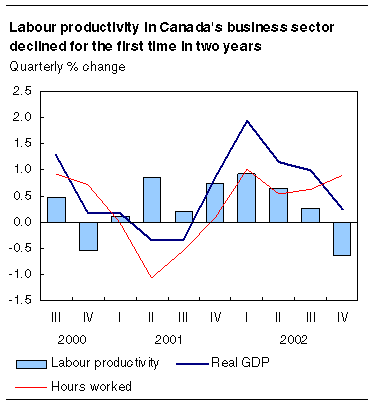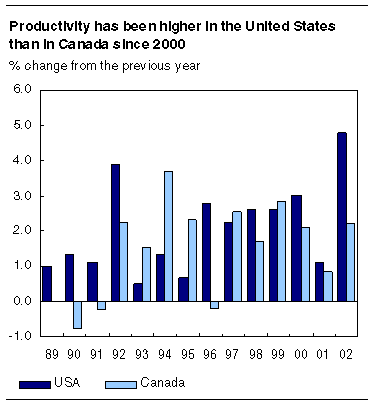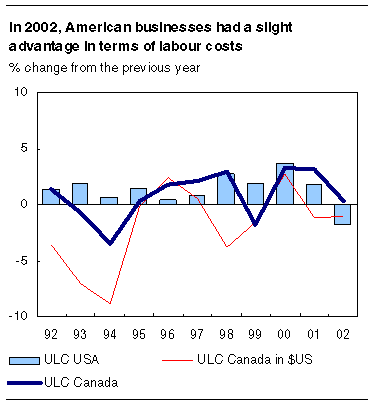
















 |
|
 |                |
Information identified as archived is provided for reference, research or recordkeeping purposes. It is not subject to the Government of Canada Web Standards and has not been altered or updated since it was archived. Please "contact us" to request a format other than those available.

|

Friday, March 14, 2003 Labour productivity, hourly compensation and unit labour costAnnual and fourth quarter 2002Labour productivity in Canada's business sector declined for the first time in two years in the fourth quarter, in the wake of a slowdown in economic activity. From October to December, productivity fell 0.6% compared with the third quarter, halting a series of eight consecutive quarterly increases. Even so, for 2002 as a whole, Canadian businesses increased their productivity by 2.2%, on the strength of productivity gains in the first three quarters. This was more than twice the rate of annual growth of 0.8% during 2001, when economic activity was weak. 
South of the border, labour productivity in the American business sector rose only a marginal 0.1% in the fourth quarter. However, for the year as a whole, productivity in the United States soared at 4.8%. This was the largest annual growth rate since 1950. Last year was the third straight year in which annual productivity growth among American businesses exceeded that of their Canadian counterparts. However, in the past few years, initial estimates of quarterly differences in productivity growth between the two nations have been reduced after data revisions. The United States have revised their estimates downward substantially, and Canada has revised its estimates upward, although much more modestly Slowdown in production hits business sector productivity on both sides of the borderOn a quarterly basis, labour productivity on both sides of the border felt the impact of a slowdown in economic activity in the fourth quarter. In the third quarter, production (GDP) had increased 1.0% in Canada and 1.3% in the United States. In the fourth quarter, production growth slowed to 0.2% in Canada and to 0.4% in the United States. Since the start of 2002, output in Canada has gradually slowed from one quarter to the next, whereas in the United States, output evolved in a seesaw pattern. 
Higher productivity growth in 2002On an annual basis, the better productivity performance south of the border stemmed mainly from differences in labour market performance in 2002. Canada has outpaced the United States for the last four years in terms of annual employment growth. In 2002, the number of hours worked declined 2.0% in the United States, but increased 1.5% in Canada. As for the labour market, output growth from Canadian businesses has also surpassed that of their American counterparts in the last four years. Business sector real gross domestic product (GDP) increased 3.8% in Canada in 2002, a much stronger increase than the 2.7% gain in the United States. Real GDP growth was stronger in Canada than in the United States in 2002. However, the decline in the number of hours worked in the United States led to growth in labour productivity south of the border representing more than double that of Canada. Slight advantage for American businesses in labour costsAmerican businesses also developed a slight advantage over Canadian businesses in the evolution of labour costs. On an annual basis, unit labour costs increased 0.3% from 2001 in Canada, compared with a decline of 1.7% in the United States, as measured in their respective national currencies. 
The unit labour cost gap between the two nations in 2002 was the result of a slower gain in labour productivity in Canada, since increases in hourly wages were virtually identical in both. Hourly wages rose 2.9% in the United States in 2002, compared with 2.6% in Canada. Measured in US dollars, the advantage of American businesses with respect to unit labour costs was less pronounced in 2002 but remained important. The unit labour cost of Canadian businesses fell 1.1% from 2001, compared with the record decline of 1.7% in the United States. Available on CANSIM: table 383-0008. Information on methods and data quality available in the Integrated Meta Data Base: survey number 1402. A more detailed analysis, including additional graphs and tables, as well as a technical note on quarterly estimates of labour productivity, are available on request. To order copies, send an e-mail message to productivity.measures@statcan.gc.ca. The detailed analysis will soon also be available on Statistics Canada's website. For more information, or to enquire about the concepts, methods or data quality of this release, contact Jean-Pierre Maynard (613-951-3654; fax: 613-951-5403; maynard@statcan.gc.ca), Micro-Economic Analysis Division.
| ||||||||||||||||||||||||||||||||||||||||||||||||||||||||||||||||||||||||||||||||||||||||||||||||||||||||||||||||||||||||||||||||||||||||||||||||||||||||||||||||||||||||||||||||||||||||||||||||||||||||||||||||||||||||||||||||||||||||||||||||||||||||||||||||||||||||||||||||||||||||||||||||||||||||||||||||||||||||||||||||
|
|
|